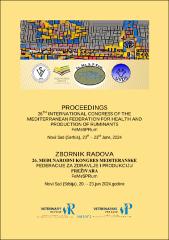| dc.contributor.author | Staničkov, Nenad | |
| dc.contributor.author | Majkić, Mira | |
| dc.contributor.author | Cincović, Marko | |
| dc.contributor.author | Đoković, Radojica | |
| dc.contributor.author | Petrović, Miloš Ži. | |
| dc.contributor.author | Nikolić, Sandra | |
| dc.contributor.author | Grubač, Siniša | |
| dc.date.accessioned | 2024-07-10T08:42:46Z | |
| dc.date.available | 2024-07-10T08:42:46Z | |
| dc.date.issued | 2024-06-20 | |
| dc.identifier.isbn | 978-86-7520-611-8 | |
| dc.identifier.uri | https://repo.niv.ns.ac.rs/xmlui/handle/123456789/845 | |
| dc.description.abstract | Pooled blood samples are an economical and high-quality way to show the state of a certain population, as well as the response of the population to certain factors of the external and internal environment, the use of pooled blood samples in veterinary medicine and related fields has found wide application, whether it is for the diagnosis of infectious diseases , the use of samples in internal quality control in the laboratory or in the diagnosis of various diseases. Creating a pooled blood sample saves time and reduces the cost of analysis,and enables easier storage of the sample, while individual samples require greater space, time and financial resources, with a greater source of errors. In the analytical sense, a larger volume of the collective sample (made up of a small volume of a larger number of samples) of blood enables a better determination of the detection limit, while in the case of individual samples, a sufficiently large amount of that one sample must be provided. Statistically estimable also differs, so with a pooled blood sample we can estimate the mean, but not the variability as in a population of individual samples. As a general rule, the mean value of the collected samples should be close to the middle of the reference range to be considered normal. The criteria for the interpretation of mean values have not been fully defined. It is considered that the mean value obtained should be in the range of 1 or 1.3 standard deviations in the reference population in order to be able to conclude that there are no individuals with significant metabolic problems. It was found that if there are up to 10% of abnormal metabolic values in the population, we will have a small deviation of the pool value from the population mean, which will amount to about 0.26 standard deviations, but that it largely depends on the analyte being measured. Our results showed that the average value of individual blood samples and the concentration obtained by pooling those individual samples give almost identical values that change identically as a function of the lactation period and the health of the cows. Due to all of the above, the preparation of pooled samples can be an interesting tool in the evaluation of the metabolic profile of larger cow populations. | en_US |
| dc.description.sponsorship | This paper was created as a result of research within the "Agreement on the transfer of funds for the financing of scientific research work of teaching staff at accredited Higher Education Institutions in 2024, contract registration number: 451-03-65/2024-03/ 200117” | en_US |
| dc.language.iso | sr | en_US |
| dc.source | Zbornik radova, 26. Međunarodni kongres mediteranske federacije za zdravlje i produkciju preživara FeMeSPRum, Novi Sad | en_US |
| dc.subject | cows | en_US |
| dc.subject | metabolic profile | en_US |
| dc.subject | pooled blood sample | en_US |
| dc.title | Uticaj perioda laktacije i zdravlja na vrednost parametara u zbirnom uzorku krvi | en_US |
| dc.title.alternative | The influence of the lactation period and health on the value of the parameters in the pulled blood sample | en_US |
| dc.type | Conference paper | en_US |
| dc.identifier.doi | 10.5937/FeMeSPRumNS24031S | |
| dc.citation.spage | 257 | en_US |
| dc.citation.epage | 264 | en_US |
| dc.citation.rank | M63 | en_US |
| dc.type.version | published | en_US |

